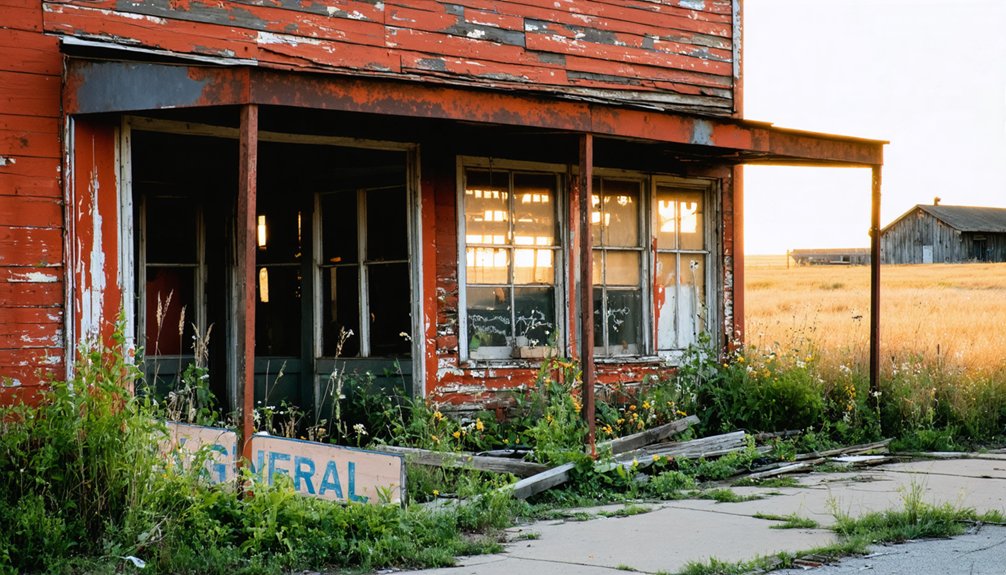You’ll find Fremont’s ghost town remains in St. Rose Township, Clinton County, Illinois, 8 miles north of Breese. European settlement began in 1835, with William Fenwick building the first house in 1836. The township, officially named in 1850, thrived on agriculture and community life until mid-20th century abandonment. Today, gravel roads wind through farmland where the old town once stood at 505 feet elevation, while thousands of preserved documents tell its deeper story.
Key Takeaways
- Fremont was established in 1835 in Clinton County, Illinois, and became a ghost town after economic decline and population shifts.
- Located 8 miles north of Breese at 38°43′39″N and 89°31′12″W, the abandoned town site is now surrounded by farmland.
- The town’s economy was primarily agricultural, featuring Tom Payne’s nursery operation and traditional Midwestern farming practices.
- Transportation changes, lack of infrastructure investment, and younger residents moving to cities contributed to the town’s abandonment.
- Historical records from 1850-1961, including township meetings and voter lists, are preserved through digital archives and databases.
Early Settlement and Township Formation
While the area that would become Fremont Township remained largely unsettled until 1835, European settlement began in earnest when William Fenwick built the first house on Diamond Lake’s south side in 1836.
Tom Payne joined the early settlers that same year, helping establish the foundation of the community.
You’ll find that by 1837, the Fort Hill Settlement had emerged as a focal point of community organization in the township’s northwest area.
The first post office opened in 1839 under Charles Darling’s management, though it ceased operations by 1842.
After years of informal governance, residents gathered on January 12, 1850, to vote on the township’s name.
While “Gilmer” won initially, “Fremont” was ultimately chosen as a compromise, honoring John C. Frémont.
The township’s formation required careful geographical clarification to prevent confusion with other similarly named locations in the region.
This careful naming process was essential, as Fremont became one of many locations requiring disambiguation efforts to distinguish it from other places sharing the name.
Geographic Location and Landscape
The geographic setting of Fremont reveals its place in Illinois’s agricultural heartland. You’ll find this ghost town in St. Rose Township, Clinton County, situated 8 miles north of Breese at coordinates 38°43′39″N and 89°31′12″W.
Standing at 505 feet above sea level, the landscape features gently rolling terrain typical of the Midwest’s farming regions. The area’s appeal once drew visitors via the South Pacific Railroad, creating a bustling stop for travelers admiring the bay views.
The land use patterns reflect significant environmental changes over time. What was once prairie has transformed into expansive agricultural fields, with corn and soybeans now dominating the vista. Similar to Buda’s population which declined from 1,500 to under 500 residents, the area has experienced dramatic changes over the decades.
Prairie grasses gave way to endless rows of corn and soybeans, forever changing the landscape of America’s heartland.
You’ll notice the remnants of the old town surrounded by farmland, accessed by gravel roads that trace its former layout. While the town’s infrastructure has largely vanished, the rural character of the American Bottoms region persists in this quiet corner of Illinois.
Historical Documentation and Records
In Fremont Township’s records, you’ll find well-preserved annual town meeting minutes dating from 1850 to 1961, offering insights into local governance and community decisions.
The Township Clerk’s office has undertaken extensive digitization efforts to protect these historical documents, making thousands of pages accessible online. The records show how early township officials carried out varied responsibilities that differ significantly from modern governance duties.
Located eight miles north of Breese, this now-abandoned settlement left behind detailed administrative records that provide a window into its past operations.
Your research into the township’s past can now benefit from these digitized records, which include voter registrations from notable years like 1868, 1870, 1871, and 1873.
Township Meeting Minutes Preservation
Historical preservation efforts surrounding Fremont’s township meeting minutes represent an important window into the ghost town‘s administrative past.
Many documents were simply carried by officeholders rather than properly archived, leading to fragmented historical documentation.
Like many communities from the 1880-1940 period, Fremont’s meeting records reflect the town’s participation in America’s westward expansion.
You’ll find that meeting preservation has faced significant challenges, as early records were often informally maintained and vulnerable to damage.
The archival challenges have prompted modern conservation methods to protect these valuable records. You can now access surviving minutes through climate-controlled storage facilities, while digital scanning guarantees long-term preservation.
Local historical societies work alongside township officials to maintain these vital documents, which reveal critical details about Fremont’s establishment, development, and eventual decline.
These preserved records help piece together the story of how this once-thriving community became a ghost town.
Record Digitization Progress Analysis
Since launching extensive digitization efforts, Fremont Township’s historical records have undergone systematic preservation through modern scanning technologies.
You’ll find thousands of deteriorated township documents now accessible through digital archives, including handwritten Annual Town Meeting minutes from 1850 through 2013 and Highway Commissioner records spanning 1883 to 1906.
Record accessibility has expanded through multiple platforms, with census data from 1820 to 1930 available on microfilm at the Fremont Public Library. The new microfilm reader allows patrons to print or email copies of historical documents.
You’ll discover these materials integrated into the Illinois Digital Heritage Hub, connecting you to a broader network of state history.
The digitization includes detailed county atlases featuring property ownership maps and business directories, offering insights into the township’s economic and social development across two centuries.
The preservation project includes a substantial collection of oral histories from local veterans and civil rights activists, adding personal narratives to the township’s documented past.
Township Governance and Community Life
Township meeting records, though sparse, indicate regular gatherings where residents discussed road maintenance, property boundaries, and local ordinances.
The township board managed community health through basic sanitation regulations and emergency response protocols, reflecting the self-governing nature of small frontier settlements.
Like many small settlements of the era that faced economic downturns, Fremont’s local government worked to maintain basic services despite dwindling resources.
You’ll find that Fremont’s early government formation followed the typical Illinois township structure, with locally elected trustees overseeing community affairs.
Early Government Formation
As Illinois formalized its township system around 1850, Fremont established its local government within St. Rose Township of Clinton County.
You’ll find that early township responsibilities centered on practical matters essential to frontier living. Officials managed everything from agricultural regulations to public health concerns, including restricting free-roaming stud horses and posting warnings about Scarlet Fever outbreaks.
The governance challenges were significant, as officials had to balance the diverse needs of farmers, tradespeople, and families.
They held town meetings in private homes, where residents gathered to make vital decisions about policies and budgets. These meetings served as the primary venue for community input, ensuring settlers had a voice in decisions affecting their daily lives and livelihoods within the larger county and state structure.
Township Meeting Records
When Fremont Township began preserving its meeting records in 1850, officials documented thousands of pages of handwritten minutes, resolutions, and ordinances that captured the community’s civic life.
You’ll find evidence of robust township governance in the detailed voter registration lists from 1868 through 1897, alongside highway commissioner records spanning 1883 to 1906.
The township’s commitment to community engagement shines through these archives, where you’ll see how residents directly influenced local policies during annual town meetings.
Through these preserved documents, you can trace how the township handled everything from livestock regulations to public health advisories.
The records, now digitally preserved and publicly accessible, include census microfilm from 1820 to 1930, offering an extensive look at Fremont’s early democratic process.
Community Health Management
The robust community health management system in Fremont Township builds upon its diverse demographic makeup and strong economic foundation. You’ll find community wellness initiatives supported by a median household income of $114,916, enabling better access to healthcare services across the region.
The township’s approach to health management includes:
- Support for an aging population, with 21% of residents aged 65 or older requiring specialized health services.
- Integration of green spaces and Forest Preserve lands covering 17.87% of the area, promoting outdoor activities and physical wellness.
- Economic stability through low poverty rates of 4.2%, contributing to improved health outcomes.
These health initiatives benefit from strong community involvement and excellent facilities, ensuring you’ve got access to resources that enhance your overall quality of life.
Agricultural and Economic Activities
Pioneering settlers who established Fremont, Illinois built their community’s economic foundation on agriculture, with Tom Payne’s ambitious farming venture evolving into Lake County’s first major nursery operation of over 100,000 trees.
Local farming practices included traditional Midwestern crop rotation methods, focusing on staple grains and vegetables. You’d find the town’s infrastructure designed around agricultural needs, with wooden plank drives leading to grain scales and storage facilities.
The community’s economic viability depended on farming-related activities like tool maintenance, milling, and small-scale trading.
Despite the region’s broader shift toward coal mining and industrialization, Fremont remained primarily agrarian.
Eventually, the challenges of maintaining profitable farming operations, combined with rural depopulation trends and mechanization, led to the town’s decline and ultimate abandonment.
Factors Leading to Abandonment

Agricultural decline marked just one component of Fremont’s path toward abandonment, as multiple forces converged to seal the town’s fate.
Economic decline and job market deterioration accelerated when transportation changes redirected major trade routes away from the settlement. Demographic shifts saw younger residents pursuing opportunities in larger cities, while cultural shifts made small-town living less appealing.
The town’s downfall can be attributed to three key factors:
Systematic factors sealed Fremont’s fate – failed policies, environmental challenges, and stagnant business growth drove its inevitable decline.
- Government policies that failed to support rural infrastructure maintenance
- Environmental hazards, including recurring flooding and soil degradation
- A severe lack of investment in modernizing local businesses and services
Without adequate resources to sustain its community, Fremont’s population dwindled until the town could no longer maintain its basic services and infrastructure.
Legacy in Illinois Ghost Town History
Located in St. Rose Township, Fremont’s legacy as an Illinois ghost town offers valuable insights into the social dynamics of rural community life.
At an elevation of 505 feet, this vanished settlement exemplifies how economic shifts and changing transportation patterns led to the decline of many Midwestern towns.
You’ll find Fremont’s story preserved in historical records, serving as a record of the broader pattern of rural settlement abandonment throughout Illinois.
Its documented history, including early settlers like Tom Payne, helps you understand the complex factors that determined a town’s survival or decline.
The remnants of Fremont continue to educate future generations about community formation, agricultural development, and the delicate balance between prosperity and abandonment in Illinois’s past.
Digital Preservation Efforts

Several digital initiatives preserve Fremont’s history through online archives and databases. You’ll find Fremont documented in the Digital Research Library of Illinois History Journal’s Lost Towns series, which offers historical narratives and photographs.
State archives maintain scanned maps and documents for remote access.
While dedicated interactive platforms for Fremont are currently limited, digital storytelling opportunities exist through:
- Online encyclopedias with crowd-sourced entries about Fremont’s ghost town status
- YouTube channels featuring regional ghost town exploration content
- Social media communities discussing Illinois ghost town histories
Digital preservation efforts primarily rely on standard metadata practices, including GNIS feature ID 1810431 for geographical referencing.
Though Fremont lacks virtual tours or 3D reconstructions, similar ghost towns have implemented WiFi-enabled experiences that could serve as future preservation models.
Present-Day Site Significance
Though Fremont’s physical structures have largely disappeared, the ghost town‘s site holds significance as an essential piece of Illinois’ rural settlement history.
You’ll find that the location serves as a valuable case study for understanding the economic challenges that have shaped rural America. While there aren’t many visible remains, the site’s cultural significance lies in its representation of broader settlement patterns and agricultural changes in the Midwest.
The area’s tourism potential remains largely untapped, but you can explore the surrounding agricultural landscape that once supported this community.
The ghost town’s proximity to Breese and its position within St. Rose Township makes it an accessible point of interest for those studying the impact of rural-to-urban migration and the evolution of farming communities in Illinois.
Frequently Asked Questions
Are There Any Remaining Structures or Ruins Visible at the Fremont Site Today?
You won’t find any remaining structures or visible ruins at this site today. Available records don’t indicate any buildings or foundations still standing, and no preservation efforts have documented surviving remnants.
What Was the Peak Population of Fremont During Its Most Prosperous Years?
You won’t find exact numbers through the fog of time, but comparing historical significance and population growth patterns of similar Illinois ghost towns, you’re likely looking at several hundred residents max.
Did Any Notable Historical Figures or Events Originate From Fremont?
You won’t find any nationally notable figures from this settlement. The only historical significance comes from early settler Tom Payne, who established Lake County’s first nursery with 100,000 trees in 1836.
Were There Any Schools, Churches, or Businesses Operating in Fremont?
You won’t find concrete evidence of Fremont education or commerce in historical records. While 60% of Illinois ghost towns typically had basic services, no primary sources confirm any institutions operated in Fremont.
What Native American Tribes Originally Inhabited the Fremont Area Before Settlement?
You’ll find the Illinois Confederation (Illiniwek) dominated this area’s tribal history, with sub-tribes like Cahokia, Kaskaskia, and Peoria holding cultural significance until being displaced by Kickapoo in the mid-1700s.
References
- https://en.wikipedia.org/wiki/Fremont
- https://fremonttownship.com/history/fremont-historical-documents/
- https://www.youtube.com/watch?v=gM3ZIgtFzBk
- https://www.geotab.com/ghost-towns/
- https://drloihjournal.blogspot.com/p/lost-towns-of-illinois-series.html
- https://fremonttownship.com/history-of-fremont-township-il-usa/
- https://kids.kiddle.co/Fremont
- https://drloihjournal.blogspot.com/2022/09/lost-towns-of-illinois-fremont-illinois.html
- https://en.wikipedia.org/wiki/List_of_ghost_towns_in_Illinois
- https://en.wikipedia.org/wiki/Fremont_Township



